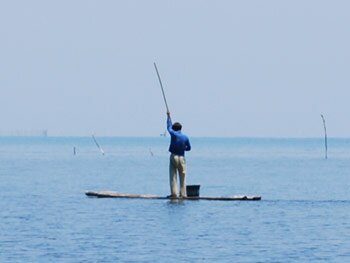 |
|
Artisanal fisherman (M King)
|
Coral reefs are the richest repositories of marine biodiversity across Southeast Asia. They are important economic assets, contributing more than $1 billion annually to the Philippines economy through the provision of food, employment and export income to the people of the Philippines.
The coral reefs in Lingayen Gulf are some of the most endangered in the Philip pines and Southeast Asia. Thousands of people directly depend upon the Gulf’s coral reefs for food, but fisheries catch is typically low due to overfishing and persistent destructive fishing, although some effort is being exerted to reduce or eliminate them.
The reefs of the Bolinao are of the fringing type, with slopes dropping to 120m in certain areas. Reef flats are mostly sandy-muddy and covered with seagrasses and seaweeds while some forereefs extend up to several kilometres from the shore, with coral cover in certain places reaching down to about 30m. Live coral cover averages about 20%. There are more than 100 fish species. However, important fish groups and mammals, such as sharks and dolphins that were previously observed along the Bolinao Channel (ca. 1950’s) are no longer common in the area.
Coral reef fisheries represent an average of 15% of the total Philippine fisheries production, although in certain municipalities like Bolinao, their contribution may be as high as 25-30%. If properly conserved, the potential sustainable fisheries from coral reefs may be estimated at US$31,900 to $113,000 per square km (White and Cruz-Trinidad 1998). The Lingayen Gulf is also one of the major fishing grounds in northwestern Philippines. Presently the fisherfolk are experiencing dwindling fish catch due to the increasing fishing pressures in the Gulf eg overfishing, use of destructive methods, increase in the number of fishers etc) and through the degradation of its coastal habitats.
Nearly all of the Philippines’ reefs are under severe threat from economic development and climate change. Although there are 1000 Marine Protected Areas (MPAs) within the country, only 20% are functioning.